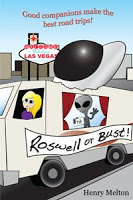 With the additional interest in ebooks caused by the Kindle and the ebook reader programs on the iPhone, the topic of valid prices for electronic books vs the price tag on a paper copy has been circulating around the net. Many big name books have the same price on the downloadable version as you’ll find on the bookstore shelf, and that has gotten some people angry. While I’ve never taken the protection route, I can understand it. Some publishers would certainly want to protect their physical book sales from being undercut by the e-versions. Probably others have contractual reasons for keeping the same price. It’s definitely hard to tell other publishers that they’re doing it wrong because this is such a chaotic business. Practically every single title has it’s own break down of costs and expenses and contract rules. You have to remember that, as a rule, every new book is a fresh negotiation. Publishers have their standard contracts, but everything is flexible.
With the additional interest in ebooks caused by the Kindle and the ebook reader programs on the iPhone, the topic of valid prices for electronic books vs the price tag on a paper copy has been circulating around the net. Many big name books have the same price on the downloadable version as you’ll find on the bookstore shelf, and that has gotten some people angry. While I’ve never taken the protection route, I can understand it. Some publishers would certainly want to protect their physical book sales from being undercut by the e-versions. Probably others have contractual reasons for keeping the same price. It’s definitely hard to tell other publishers that they’re doing it wrong because this is such a chaotic business. Practically every single title has it’s own break down of costs and expenses and contract rules. You have to remember that, as a rule, every new book is a fresh negotiation. Publishers have their standard contracts, but everything is flexible.
Pricing My Books

But back to my own prices. In 2006, I tried an experiment. I took one of my unsold novels off the shelf, Emperor Dad, formatted it as a PDF and put it on my website with a PayPal button to buy it. I asked around, but got no solid advice on what to charge for it — other than from my daughter who said it had to be cheaper than a paper copy. I chose $3 as a nice round figure, $2.99 with PayPal taking 0.39 as a transaction fee for a $2.60 net. Some friends and relatives bought it, and I had my introduction into the wild and crazy world of ebook formats. It seems some versions of PDF would text flow when loaded into a Palm Pilot, while others wouldn’t. I experimented. I also decided I really needed cover art, even going so far as to chase down an artist and pay to have one created. Still, there were no significant sales.
Forward to 2007 and my discovery of Lulu. I had the itch to produce a real book, you know the kind with paper pages. Part of the incentive was personal. My parents were getting older, and although I had printed a few titles for them on my printer and ring bound them into nice packages, it still wasn’t quite real to them. So, taking the same title, and my new cover art, I went through the free setup process and paid the fee for an ISBN number and distribution through Amazon. There was also the option to distribute an ebook version, a PDF just like I had been doing before, so to simplify matters, I shut down my private ebook webpage and just used theirs.
I chose $5 even for the Lulu ebook price, which gave me a net of $4. On the paper side, pricing was uncomfortably high. After running several spreadsheet trials to get a price point high enough so that an Amazon sale would actually produce a return, I chose $19.95. With Lulu’s high cost per unit, that gave me $2.11 for each Amazon sale. I could also get $7.66 if anyone tracked down the Lulu bookstore and bought it there. Since Amazon always discounts, there wasn’t much incentive for anyone to buy on the Lulu store. I could also buy copies in bulk for myself for $9.31 which I could then hand-sell.
A real book in hand was a revelation. My parents sat up and noticed. It became real for them. I had a book to show at conventions. Somehow one of the early copies got to Memphis and was nominated for the Darrell Awards. It won the 2008 Best Novel category.
2008, and I realized Lulu was unsustainable. Each copy was too expensive to manufacture. I asked around and discovered LightningSource. Maybe because I had done some homework and had already purchased a block of ISBN numbers and had plans for several titles, I squeaked through their vetting process and was accepted as a publisher. I pushed through two titles at the beginning. Roswell or Bust, and a second edition of Emperor Dad, with better layout and fewer pages than the first (the story was identical except for a few typo corrections). With LightningSource’s better economies of scale, I could get my wholesale costs down to around $6 per title. That original $19.95 had to come down. More spreadsheets, and I set the prices at $12.95 with a 40% distributer discount. That was a mistake.
I took a road-trip around New Mexico to introduce Roswell or Bust to bookstores where it could be considered a local interest book. I quickly discovered that some bookstores wouldn’t buy because when they went to Ingram to order, it was offered at 25% discount. I knew bookstores needed the 40%, so that’s what I had set it at, but I had neglected Ingrams’s cut. I went back to LightningSource and changed the list price to $14.95 with a 55% discount. That meant I had to change the price everywhere, so on my own webstore page, I increased the list price, but added free shipping to compensate.
So, at my current pricing, I get about $1.70 for each Amazon or B&N online type sale, and much better for anyone who buys from me direct with the offer of autographing, free shipping and no questions returns. The direct sales aren’t huge but they do help compensate for all the free books I send out to reviewers (it’s a big expense for me).
On the ebook side, I put Emperor Dad into the Kindle store almost as soon as they opened it up, but there were no sales for quite a while. Then Touch Tomes asked about making an ebook iPhone App. When we talked pricing, I suggested $5, since that is what I had used for the Lulu PDF and the Kindle version. It worked. Sales began picking up on the ebook side. I acquired Mobipocket Creator and made mobi versions of my titles and put them into that distribution chain as well, also for the $5/$4.95 list price.
The results, after considering store discounts, and partner splits are remarkably similar. Amazon Kindle discounts to $3.96 and then takes their cut leaving me $1.73.
On the iTunes store, the $4.99 has 30% going to Apple, and I split with Touch Tomes giving me 35% or about $1.75. Mobipocket sales give me $1.73, but that varies by the euro/dollar exchange rate. All of these are right in line with the net of a paper sale through a distributer, so I really have no problem with e-book sales vs paper sales.
My target price of $5 for e-sales list was just a shot in the dark, but I’m quite pleased with how it’s worked out. Yes, I’d prefer to sell you paper copies direct and chat with you personally, but I still have hopes of becoming wildly popular and I would rather not spend all my time packing and shipping books.

I completely understand why you took the approach that you did. And for your project, it’s probably a good one. I suspect that you may already know the following, but just in case your readers don’t, let me say:There are other pricing models out there. I understand that you’re doing "first fiction" or fiction by authors without a following. That’s a really tough sell, and the lowest common price is probably a good idea. (Don’t price any lower than the common run of fiction in your format — hb, tpb, mpb or ebook — or your audience will probably decide that there’s something wrong with the book.)If you had non-fiction, or at least a following already, I would suggest that you do the full-dress analysis. It takes about 2-3 hours, but it’s usually well worth the time. You do a sales estimate on comparable titles (see the blog on my site, GropenAssoc.com, for some techniques to help with that), then fit the sales vs price data to a line, estimate your book’s sales at a given price, estimate your costs at several points around that price, the change in sales with a change in price, and then, last, but not least, which price will yield the best profit.It sounds much harder than it is. Truly. If you get the price wrong by just a dollar and only on half of your titles, and if you sell a minimal 2,000 copies per title, you’re losing $2,000 for every other title. That means that the 4 to 6 hours of work (for those two titles) would have netted that $2,000 in profit to your company. And that’s a pretty hefty hourly wage. I wish you all good luck, and hope that my brief suggestion offers some help for your future pricing decisions.
An interesting article. It shows how if you do not know something, just give it a shot and see what happens. Learn by doing.
Been a while since I looked back at this blog post.
I was curious to know whether the new Amazon price policies for self-published books are going to make any difference in the way you price your Kindle editions. Since you're going to get 70% of the sale price (assuming the rest of their terms are acceptable), are you planning to make any changes to it?
I'm going to have to look very closely at the Amazon terms before I make any change, and since it's still months away before anything happens, I haven't taken that step.